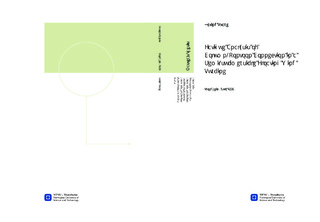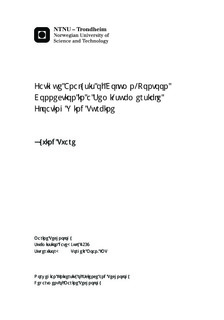| dc.contributor.advisor | Moan, Torgeir | nb_NO |
| dc.contributor.author | Tvare, Øyvind | nb_NO |
| dc.date.accessioned | 2014-12-19T12:13:12Z | |
| dc.date.available | 2014-12-19T12:13:12Z | |
| dc.date.created | 2014-10-17 | nb_NO |
| dc.date.issued | 2014 | nb_NO |
| dc.identifier | 756655 | nb_NO |
| dc.identifier | ntnudaim:11981 | nb_NO |
| dc.identifier.uri | http://hdl.handle.net/11250/239230 | |
| dc.description.abstract | In a world with ever increasing energy demands, there is a need to find new ways to harvest renewable energy. Floating offshore wind turbines could be an important energy source in the future. To make this possible a better understanding of offshore wind turbines is essential. This thesis has dealt with fatigue associated challenges related to a column-pontoon connection in a semi-submersible floating wind turbine developed at CeSOS, NTNU.The specific design investigated in this report has a transition hull from the cylindrical column to the rectangular pontoon. A finite element model of the connection was available and revealed very high stress concentration at some areas. The sub-modeling technique was applied at two crucial areas for a detailed stress analysis. The design of the connection was changed in order to reduce the stress concentration.Fatigue analysis were carried out at the intersection between the midpoint at the upper hull of the pontoon and the transition piece. The same was done at 13 points along the weld between the hull of the transition piece and the hull of the column. Load time series from global dynamic response analysis from 13 sea states, representing wave and wind conditions at deep water in the North Sea with 0, 30, and 60 degree wave heading, were available and used in fatigue calculations. Load time series from -30 and -60 degree heading were created assuming symmetry around the vertical midplane of the structure. 10 one hour simulations of every sea state were used.Cumulative fatigue damage at all sea states and wave headings were calculated and compared using rainflow counting, an appropriate S-N curve and Miner's rule. Estimated time to failure is calculated assuming a constant wave heading over the lifetime of the structure. The estimated fatigue life is also determined for a combined wave heading. The combined wave heading corresponds to the column-pontoon connection where 0 degree heading is dominating.There will be a multiaxial stress state at the different hot spots. A simplified method for including the fatigue damage contribution from all the different stress components (stress parallel with the weld, stress normal to the weld and shear stress) is proposed. The method has large limitations, but is intended to be used when there is a close to linear relationship between the different stress components. This method has been used when predicting fatigue life at all hot spots and the results have been evaluated.Estimated fatigue life at the most critical hot spot is 1.9 years under a combined wave heading. Multiple hot spots have a fatigue life under 10 years. More design changes is needed to achieve acceptable fatigue life. The method proposed for including multiaxial fatigue effects show promising results at some hot spots. The accuracy depends on which hot spot is analyzed and wave heading. | nb_NO |
| dc.language | eng | nb_NO |
| dc.publisher | Institutt for marin teknikk | nb_NO |
| dc.title | Fatigue Analysis of Column-Pontoon Connection in a Semi-submersible Floating Wind Turbine | nb_NO |
| dc.type | Master thesis | nb_NO |
| dc.source.pagenumber | 117 | nb_NO |
| dc.contributor.department | Norges teknisk-naturvitenskapelige universitet, Fakultet for ingeniørvitenskap og teknologi, Institutt for marin teknikk | nb_NO |

